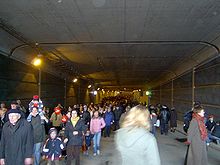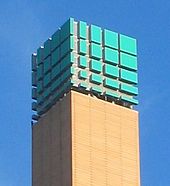Tiergarten Spreebogen tunnel
|
|
|
|---|---|
|
Northern entrance on Minna-Cauer-Strasse
|
|
| use | Road tunnel |
| traffic connection | Bundesstrasse 96 |
| place | Berlin |
| length | 2392 m |
| vehicles per day | 44,000 vehicles / d |
| Number of tubes | 2 |
| construction | |
| building-costs | € 390 million |
| business | |
| release | March 26, 2006 |
| Coordinates | |
| Minna-Cauer-Strasse | 52 ° 31 '35 " N , 13 ° 22' 3" E |
| Invalidenstrasse | 52 ° 31 '30 " N , 13 ° 22' 4" E |
| Tiergartenstrasse | 52 ° 30 ′ 44 " N , 13 ° 22 ′ 15" E |
| Reichpietschufer | 52 ° 30 ′ 22 " N , 13 ° 22 ′ 20" E |
The Tiergarten Spreebogen Tunnel , TTS for short , is a road tunnel in Berlin that crosses under the Spree south of the main train station and then under the Tiergarten in the center of Berlin .
course
The road tunnel is 2,392 meters long.
It is designed as a rectangular frame structure with two tubes - separated by a central wall. Each tube has a standard cross-section of 10.50 meters and accommodates two lanes, an emergency stop lane and two emergency walkways. Five emergency exits are arranged along it.
The tunnel begins in the north with an access on Minna-Cauer-Strasse, which was rebuilt together with the tunnel as a continuation of Heidestrasse. This is followed by a south-facing partial junction on Invalidenstrasse . In the further course the tunnel crosses under the main station and the Spree, leads underground past the Chancellery and crosses under the zoo with the Straße des 17. Juni . This is followed by the Kemperplatz sub- junction at Tiergartenstrasse . The tunnel ends on the banks of the Landwehr Canal ( Reichpietschufer / George C. Marshall Bridge ). The junctions Invalidenstraße and Kemperplatz are designed as a left exit. Furthermore, the parking garage at the main station and the logistics access to the Sony Center and the debis building are connected to the tunnel underground.
The tunnel forms the western section of the inner city ring . It is part of the federal highway 96 .
history
The Tiergarten Spreebogen tunnel was built as part of the “ Tiergarten Tunnel ” complex of traffic systems in the central area of Berlin after the reunification of Germany and the two parts of Berlin.
The construction pit was created using back-anchored sheet pile walls and a high-lying sealing base (HDI) with buoyancy anchors. After they had been excavated - 550,000 m³ dry and a further 315,000 m³ in the groundwater - the tunnel could be built in a stepped process. 190,000 m³ of concrete and 20,000 tons of steel were used for this. Then the excavation pit was filled with 350,000 m³ of earth and the surface of the area was designed. The construction costs amounted to 390 million euros.
The former relief road was largely replaced by it and its area reintegrated into the zoo.
On March 19, 2006, the structure could be explored on foot as part of an "Open Tunnel Day". The tunnel was opened to road traffic on March 26, 2006.
business
The maximum permissible speed in the tunnel is 50 km / h. The tunnel is monitored around the clock in the tunnel control center. It is equipped with video surveillance, radio and mobile phone coverage, 258 variable message signs and tunnel loudspeakers.
In the initial phase after the tunnel was opened, the volume of traffic remained well below the forecast 50,000 vehicles per day. A year after the opening, the occupancy rate had increased to 44,000 per day. The total capacity of the tunnel is given as 50,000 vehicles per day .
In 2007, the Tiergarten Spreebogen tunnel received the grade “very good” in a test by the ADAC , which assessed various tunnels with regard to safety, and came first among the tunnels tested in Germany.
Criticism of the construction project
The tunnel construction was already the subject of disputes and legal proceedings as well as public controversy during the planning from 1992. In terms of content, the focus was on environmental compatibility , noise pollution for residents and the fundamental necessity and adequate dimensioning of the project.
In 1995 an urgent application for a construction freeze was made by a nature conservation association (Berliner Landesarbeitsgemeinschaft Naturschutz e.V.) and several tenants of apartments in the area of the construction project, which was rejected by the Federal Administrative Court .
Another point of criticism is the enormous construction and maintenance costs of the road tunnel. The construction of the road tunnel cost around 390 million euros, the maintenance costs 750,000 euros annually. For comparison: in 2006 Berlin spent a total of 67.2 million euros on road construction and 115.4 million euros on road repairs and maintenance.
The exhaust gases from the tunnel are emitted unfiltered through exhaust chimneys at the main station and at Potsdamer Platz . The installation of a filter technology for 5.4 million euros was waived.
Possible extensions
The route of the tunnel corresponds to a section of the decades from the West Berlin Senate proposed and then rejected Westtangente . As a continuation of this, the southern end of the Tiergarten tunnel could be extended, running adjacent to the course of the railway at the south exit of the north-south tunnel , and connected at Sachsendamm with the northern end of the existing A 103 to Steglitz . Due to historically grown political controversies about the western bypass, this further construction is not planned, and the suggested advance payment of an intersection-free exit at the southern exit was rejected.
Others
The Tiergarten Spreebogen tunnel was used for filming as early as 2004 - two years before it went into operation. In the movie The Bourne Conspiracy , several vehicles engage in a wild chase. The scene takes place in Moscow , but was shot in the Berlin tunnel shell.
In 2010, recordings were made for the Bushido film Times Change You .
In addition, recordings were made in the Tiergarten Spreebogen tunnel from 2014 for the film Who Am I - No system is safe .
literature
- Tunnel construction report. In: Berlinische monthly 7/2001 at the Luisenstädtischer Bildungsverein .
- Justification of the judgment of the Federal Administrative Court on the rejected urgent procedure. BVerwG 11 VR 38.95 - Decision of November 28, 1995 No. 703.
Web links
- Tunnel Tiergarten Spreebogen - TTS (PDF; 1.9 MB) Senate Department for Urban Development
Individual evidence
- ↑ a b c d e f Senate Department for Urban Development (ed.): Tunnel Tiergarten Spreebogen - traffic clearance for city road tunnel in the course of the B 96 (Flyer) . 2006.
- ^ Berlin Central Station - The Project . Senate Department for Urban Development
- ↑ a b Approval for the Tiergarten Tunnel on March 26, 2006. Senate Department for Urban Development, February 24, 2006, accessed December 30, 2018 .
- ↑ Klaus Kurpjuweit: Fear of diving . In: Der Tagesspiegel , April 5, 2006
- ↑ Thomas Fülling: 44,000 cars pass under the zoo every day . ( Memento from September 30, 2007 in the Internet Archive ) In: Berliner Morgenpost , June 5, 2008
- ↑ TTS road tunnel test report by ADAC, 2007
- ↑ Press release of the BVerwG No. 37/1995 of November 28, 1995
- ↑ Die Welt , March 27, 2008
- ↑ Berlin House of Representatives (2006): Small question from the MPs Claudia Hämmerling ( Bündnis 90 / Die Grünen ) of January 11, 2006 and answer




